Making Fire in the Rain - A Guide, the Main Problems and How to Overcome Them
Don't let bad weather stop you. Even in the rain and snow, light a well-burning campfire and stay warm and dry in the wilderness with our ultimate guide.
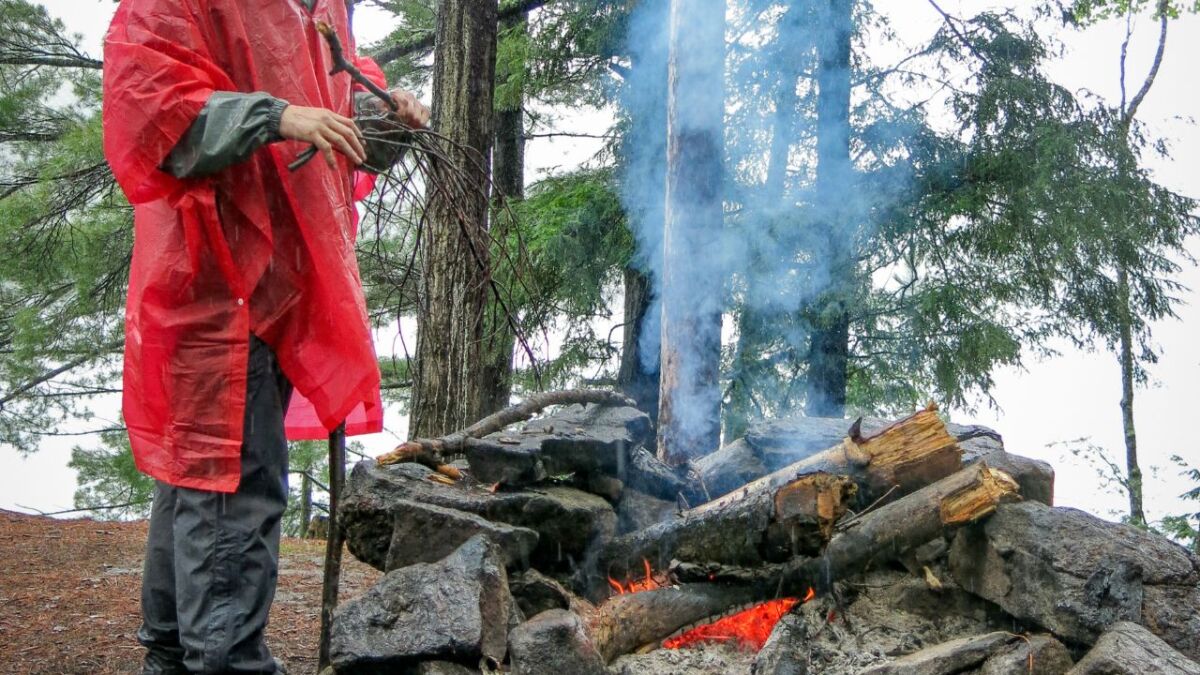

From Martin Gebhardt. Check out my “About me” page.
👉 The key facts from this guide
- You can also ignite a campfire and stay warm in rainy and snowy weather.
- Making a fire in bad weather is an important skill as it can keep you warm, cook food, and send signals.
- The three key elements for a stable fire are tinder, kindling, and firewood.
- Choose a protected location for your fire to protect it from rain and use dry wood and tinder.
- You can find dry wood at the base of trees or inside thick woods, known as heartwood.
- Natural fire starters like birchbark and Fatwood can also burn well when wet.
Do you know this?
You are in the middle of the wilderness, it's pouring rain, you are soaked and all you wish for is to ignite a hot, crackling fire - but that seems almost impossible.
This problem is encountered by outdoor adventurers time and time again.
The damp environment and the incessant rain make it difficult to start a fire, and you just don't know what to do.
Don't worry, my friend.
With the right techniques and a little know-how, making fire in bad weather is no longer a mystery.
I will show you how to do it.
A fire in bad weather should be on your skills list
Fire is not only romantic, it can also be a lifesaver.
Especially in the rain, it can make the difference between a dreary night and a warm, cozy evening walk.
It allows you to warm up, cook food, and even send signals for help.
Challenges when lighting in the rain
The greatest enemy of a blazing campfire is undoubtedly water.
The moisture makes it difficult to ignite the wood and the rain can quickly extinguish the flames.
The storm could throw a spanner in the works before you can say "fire".
But don't worry.
Every challenge can be overcome, provided you know how.
In this article, I will show you exactly that - how to start a fire successfully in the rain and bad weather.
Stay tuned because this will revolutionize your campfire experience.
Basics of Making Fire
Before we dive into the specific techniques for making fire in wet conditions, let's first refresh the basics.
A stable burning fire requires three key elements:
- Tinder
- Kindling
- Firewood
![Feuer machen bei Regen [Anleitung + Problemlösungen] anzuendholz aus einem stueck holz](https://survival-kompass.de/img/artikel/anzuendholz-aus-einem-stueck-holz.jpg)
- The tinder is ignited first and keeps the flame alive long enough to ignite the kindling. Tinder is like the spark in your adventurous spirit - small but powerful! It is your first line of defense against moisture.
- The kindling is like the catalyst, it catches the spark from the tinder and fuels the fire. This then generates enough heat to ignite the more difficult-to-burn firewood and keep the fire going.
- The thick firewood is the centerpiece. Once it catches fire, it maintains momentum and keeps the fire going.
Matching this, I also have guides where you can delve into the tinder in depth and in the guide "Tinder and Kindling", I show the differences exactly.
Choosing the right fire pit
Your choice of fire pit affects how well your fire burns and how safe it is. Look for a location that is sheltered from the wind and where there are no easily flammable objects around your fire.
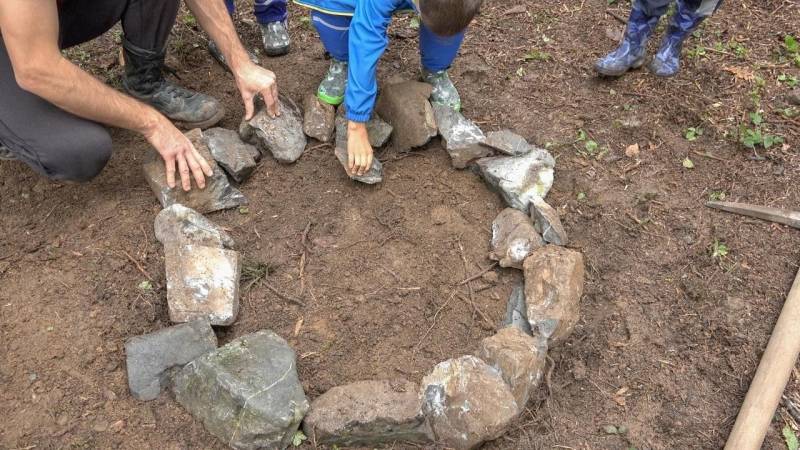
The ground should be stable - no loose sand or mud. An overhanging rock can serve as natural protection against rain, or you could even dig a small pit to protect your fire from the elements.
Furthermore, a tarp (here's my top list) can help here so that your fire doesn't get too much water.
6 proven methods to ignite fire in the rain
Okay, you already have some information. Let's go into detail now.
1. Find a safe place
In a rainy scenario, choosing the right location for your fire is even more important than usual.
If possible, find a spot under thick trees. Their branches can create a kind of natural roof and catch most of the rain.
But remember to keep a safe distance from the branches to prevent the flames from spreading.
If it's pouring rain, you should build yourself a rainproof shelter beforehand. This can be a shelter, a roof made of a tarp, or a roof made of natural materials, such as large pieces of bark.
![Feuer machen bei Regen [Anleitung + Problemlösungen] tarp plane bushcraft wald](https://survival-kompass.de/img/artikel/tarp-plane-bushcraft-wald.JPG)
2. Finding dry wood and tinder - where to look?
Moisture is a big enemy when it comes to fire. But don't be discouraged - even in a damp environment, you can find dry material for your fire, you just need to be strategic.
If you are looking for wood, pay attention to dead branches that are still hanging on the tree (see image) instead of the scattered ones on the ground.
Perfect here are the thin branches of pine and spruce, as they burn even better due to the resin.
![Feuer machen bei Regen [Anleitung + Problemlösungen] reisig unten an fichten fuer ein feuer](https://survival-kompass.de/img/artikel/reisig-unten-an-fichten-fuer-ein-feuer.jpg)
Even large branches hanging on the tree, called "Widow maker," often have a dry core region that is ideal for burning.
Or dead tree trunks that are still standing upright are a good source of firewood, as their surface is exposed to the weather while the inner part remains dry.
Below the bark, you will find a dry area in many tree species that makes good kindling.
Furthermore, hollow trees or large trunks typically provide a dry shelter for bark, dry grass, and leaves - all excellent kindling material.
3. Prepare and protect the fire pit
Before you start making a fire, prepare your fire pit carefully.
Remove all wet leaves and make sure you have enough dry material on hand before igniting the fire.
Build a kind of windbreak around your fire if possible. You can also dig a small pit to protect your fire from rain and wind.
👉 In this guide, I write more about the perfect fireplace.
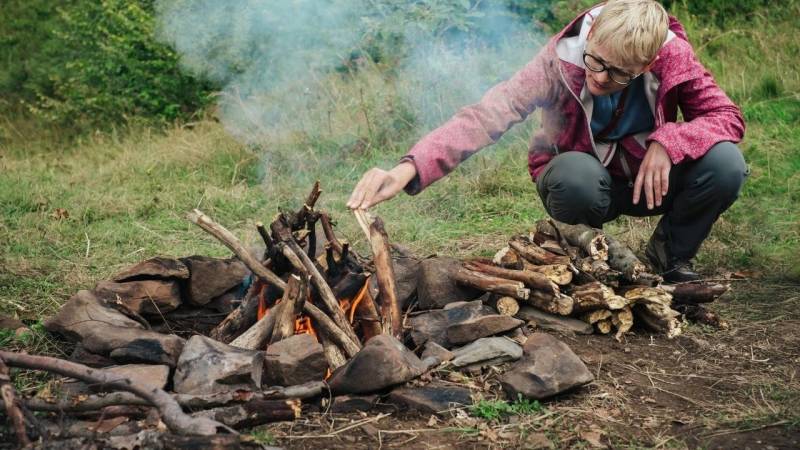
4. Use of natural fire starters
The nature is often the best supplier for what one needs to survive - even when it comes to igniting a fire.
She offers you a wealth of natural materials that are still excellent at igniting even in damp conditions.
Let's take a closer look at some of these materials, and you will see that with their help, you too can ignite a perfect campfire.
![Feuer machen bei Regen [Anleitung + Problemlösungen] flamme ins lagerfeuer bringen](https://survival-kompass.de/img/artikel/flamme-ins-lagerfeuer-bringen.jpg)
Birch Bark - the Gold of the Forest
If you are in an area with birch trees, then you are truly blessed.
The bark of the birch tree contains a wealth of natural oils that burn excellently even in strong moisture and rain.
![Feuer machen bei Regen [Anleitung + Problemlösungen] birkenrinde duenn](https://survival-kompass.de/img/artikel/birkenrinde-duenn.jpg)
These oils give the birchbark its characteristic silvery color and make it one of the best natural tinder materials ever.
Simply peel off a few strips, roughen them up slightly, and bring them close to your fire starter. You will see: It ignites almost as if by magic.
![Feuer machen bei Regen [Anleitung + Problemlösungen] feuer machen mit feuerstahl](https://survival-kompass.de/img/artikel/feuer-machen-mit-feuerstahl.jpg)
Pine resin - the resin of the pine tree
As a pine knot, the resin-soaked wood of coniferous trees, predominantly pines, is referred to.
This wood is almost rot-proof due to its high resin content and burns wonderfully even when wet.
It generates high heat and withstands even heavy rain.
It is often found in old pine roots. Furthermore, it can be easily removed with a sharp knife or axe and used as excellent kindling material.
![Feuer machen bei Regen [Anleitung + Problemlösungen] kienspan als zunder 3 bilder](https://survival-kompass.de/img/artikel/kienspan-als-zunder-3-bilder.jpg)
I have written a comprehensive guide with all my tricks for the tinder fungus. Check it out here, and you will learn where to find the gold of the forest.
More natural fire starters?
Yes, they exist - Mother Nature is rich in materials that are suitable as tinder.
Next to birchbark and fatwood, for example, the dried seed fluff of reed plants, lichens or dry moss are suitable for starting a fire.
But never forget: Every living being and every plant in the wilderness has a right to be respected. So only take what nature willingly gives you and leave the rest untouched.
![Feuer machen bei Regen [Anleitung + Problemlösungen] flechte usnea](https://survival-kompass.de/img/artikel/flechte-usnea.jpg)
5. Fire at different rain intensities
Light rain will not be able to harm your fire as long as your tinder is well protected, and you have enough dry firewood.
In heavy rain, you should seek additional protection - perhaps under a natural overhang or by building an improvised shelter.
Remember to keep your fire as high and hot as possible so that the rain evaporates before it can reach the flames.
![Feuer machen bei Regen [Anleitung + Problemlösungen] bushcraft lagerfeuer firekit](https://survival-kompass.de/img/artikel/bushcraft-lagerfeuer-firekit.jpg)
6. Security measures and tips
While making fire in the rain is a useful skill, safety is always the top priority.
- Never use gasoline or other dangerous liquids to ignite your fire.
- Always make sure your fire does not get out of control.
- Keep water or sand within reach at all times, even in light rain, to be able to extinguish it quickly.
Remember: Only an extinguished fire is a safe fire!
The Art of Fire Building: Which Structures Work Best in the Rain?
A well-planned fire structure is like a well-told campfire tale - it starts small, builds tension, and eventually unfolds in all its glory.
When it's wet weather, some fire structures can help get that perfect campfire going.
The magical tipi structure
The tipi structure is named after the conical tents of the Native Americans and is characterized by its cone-like shape.
You start by stacking some branches or small logs in the shape of a teepee and filling the inside with tinder. The fire is ignited inside and gradually spreads outward.
The advantage of this structure is that the fire ignites from the inside, spreads outward, and thus dries the wet outer wood.
It provides good ventilation and allows the fire to store heat and spread naturally at the same time. Since the top of the tipi is open, the smoke can easily escape and the fire can breathe.
![Feuer machen bei Regen [Anleitung + Problemlösungen] tipi feuer aufbau form](https://survival-kompass.de/img/artikel/tipi-feuer-aufbau-form.jpg)
The solid log cabin structure
The log cabin structure is named after the construction of log cabins and is a sturdy construction that is particularly well suited for larger fires.
One builds them by laying smaller trunks or thick branches on top of each other at right angles, similar to a Jenga tower. Each new layer is slightly smaller than the previous one, resulting in a cone or pyramid shape in the end.
![Feuer machen bei Regen [Anleitung + Problemlösungen] blockhaus feuer aufbau](https://survival-kompass.de/img/artikel/blockhaus-feuer-aufbau.jpg)
Thanks to its excellent ventilation and solid construction, the log cabin structure can also function well in a humid environment, especially if you fill the interior with plenty of dry tinder.
It provides structure, strength, and is relatively easy to assemble. Additionally, it creates a solid base for the firewood and helps to distribute the heat efficiently.
![Feuer machen bei Regen [Anleitung + Problemlösungen] feuer Log Cabin Struktur](https://survival-kompass.de/img/artikel/feuer-Log-Cabin-Struktur.jpg)
Whether you choose the tipi or the log cabin structure depends on the specific conditions and your personal preferences.
It is important that you carefully plan and build your structure and always prioritize safety. With some practice, making fire in the rain will soon no longer be a major obstacle for you.
Advanced Techniques
Fire in the Snow vs. Fire in the Rain
It may sound surprising, but making fire in the snow can actually be easier than in the rain.
Snow somewhat insulates the heat and creates a stable base for your fire, while rain constantly wants to extinguish the fire.
No matter if it's rain or snow - the principle remains the same: find dry tinder, protect the fire, and generate enough heat for it to sustain itself.
👉 Here is a further guide: "How to build and ignite a fire in the snow - the complete guide"
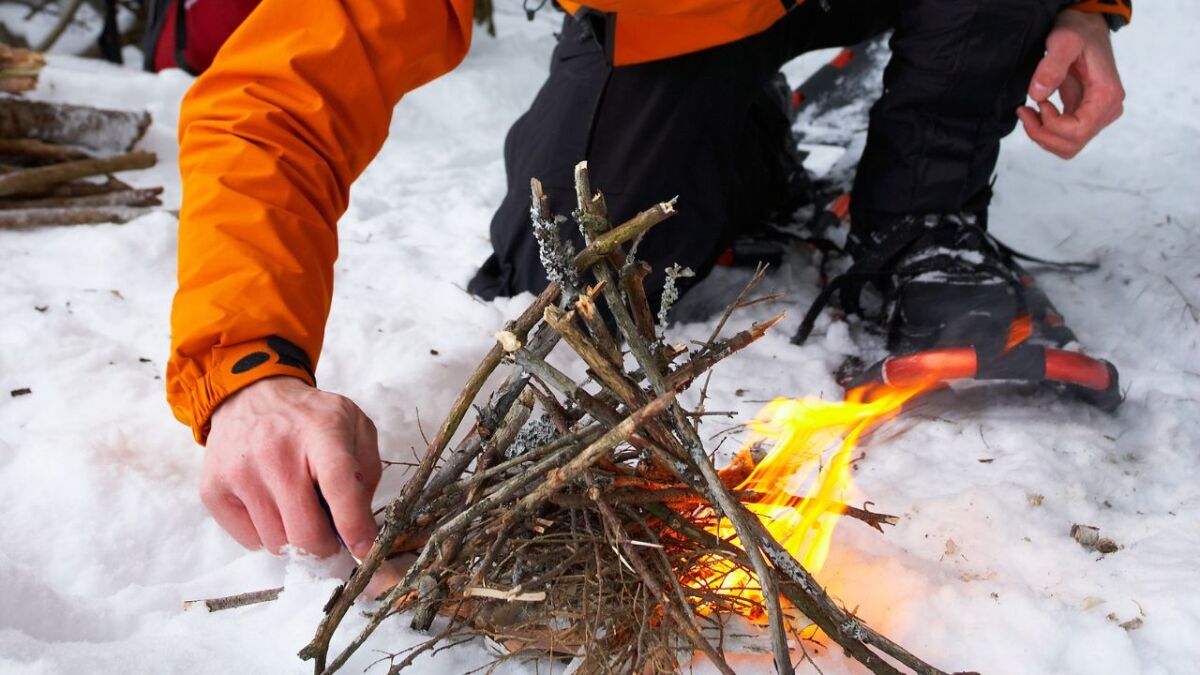
Ignition methods without conventional tools
Sporadically, the backpack with the tools stays at home, and you have to ignite a fire with what nature provides.
Firesteel (here's my top list), flint and steel, a bow drill or even a glass of water can be used to generate sparks/embers and ignite a fire.
These techniques require practice and patience, but they are worth it - after all, you can then rely on yourself in any situation.
👉 Therefore, I recommend reading my comprehensive guide: "Making Fire Without a Lighter or Matches (18 Ways)".
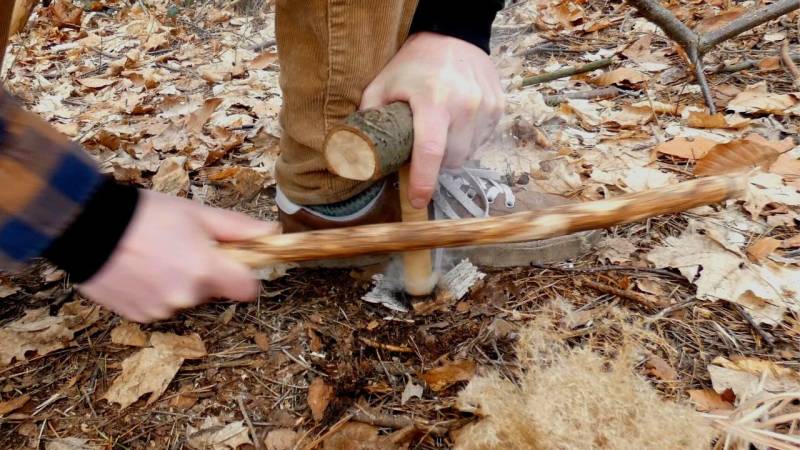
7 common mistakes when making a fire in the rain and how to avoid them
When making a fire in the rain and wet conditions, there are some common mistakes that I see over and over again in my classes.
Using wood that is too wet, not thoroughly preparing the fire pit, or not paying attention to weather conditions - these are the most common mistakes.
But not only these: the choice of location, the use of fire starters, and patience also play a crucial role.
Here are some tips on how to avoid these errors:
1. Used wood that is too wet
It can be extremely tempting to start working with the largest branches and tree trunks right away. But a common mistake is using wood that is too wet or green.
Even if you make them burn, they will produce more smoke and give off less heat.
Always look for dry wood or wood that dries quickly, such as resinous softwood.
Make sure your tinder and firewood are dry. You can collect dry leaves, bark, or small branches that are not soaked by rain.
![Feuer machen bei Regen [Anleitung + Problemlösungen] reisig duenne aeste sammeln zum feuermachen](https://survival-kompass.de/img/artikel/reisig-duenne-aeste-sammeln-zum-feuermachen.jpg)
2. Missing preparation of the fire pit
Before the fire is ignited, it is of immense importance to prepare the fire pit properly.
Remember to remove all wet and damp materials and dig a small pit to protect the fire from the wind.
Nothing is more disappointing than seeing your painstakingly built fire pit blown away in the storm.
In addition, you should use a layer of dry material such as wood, bark, or small branches as a base to isolate the fire from the wet ground.
![Feuer machen bei Regen [Anleitung + Problemlösungen] feuer im schnee aufbauen und entzuenden aufbau 1](https://survival-kompass.de/img/artikel/feuer-im-schnee-aufbauen-und-entzuenden-aufbau-1.jpg)
3. Ignoring wind and weather conditions
Wind can either fuel or completely extinguish your fire.
Given this, it is always important to keep an eye on the weather conditions. Always expect changing wind directions. With enough cover and protection, your fire can even withstand the stormiest gusts.
4. Choose an unsuitable location
Search for a location that is as protected from rain as possible.
A place under trees that keep off the rain can already help. If you have a tarp with you, you can set it up to provide additional protection.
5. Missing or unsuitable fire starters
It is advisable to use suitable fire starters such as waterproof matches, a lighter, or a fire steel. These are better suited for igniting fire in damp conditions.
![Feuer machen bei Regen [Anleitung + Problemlösungen] review light my fire feuerstahl outdoor scout](https://survival-kompass.de/img/artikel/review-light-my-fire-feuerstahl-outdoor-scout.jpg)
6. Not adequately protecting the fire
Make sure the fire is well protected. You can place a fire bowl or stones around the fire to frame it and catch sparks.
![Feuer machen bei Regen [Anleitung + Problemlösungen] perfekte bushcraft feuerstelle](https://survival-kompass.de/img/artikel/perfekte-bushcraft-feuerstelle.jpg)
7. Impatience
Making fire in the rain often requires more patience and time.
Be patient and give the fire enough time to develop. Gradually add larger fuel as the fire burns well.
A quote to ponder
As your outdoor companion, I want to encourage you to keep practicing and learning.
No skill is perfect overnight, and fire making is no exception.
Practice makes perfect - so pack your things, go out and ignite this fire!
Be patient with yourself and remember that every successful campfire setup is a combination of knowledge, skill, and respect for nature.
Lighting a fire under rainy conditions may seem difficult, but with knowledge of the right techniques and proper preparation, it is a solvable problem.
Choose the right fire pit, find dry wood and tinder, and always be prepared for weather conditions.
Never forget to respect nature and safety rules when lighting your warming and glowing campfire.
And as the famous natural philosopher John Muir once said: "In the outdoors, fire is our sunrise."
Maybe your next campfire will also be your next sunrise - not only physically, but also in your understanding and respect for nature. Good luck!


Author of the guide
Martin Gebhardt
Hey, I'm Martin. On my blog, you will learn the basics and numerous details about living in the wild. I think survival, bushcraft and the good life in nature are the keys to happiness. Find me here on Instagram or on YouTube. You can find more about my mission on the About Me page.
Was this guide helpful?
20 people found this guide helpful.
5.00 out of 5 points (20 Ratings)
Comments (0)
This post may contain affiliate links. So if you click on the links and make a purchase, I will receive a small commission at no additional cost to you. Click here, to learn more about it.



